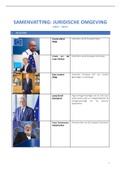Samenvatting
Summary Sensory Perception and Consumer Preference - Exam questions examples & reflection lectures (MCB-30806)
- Instelling
- Wageningen University (WUR)
Summary of the exam questions examples and reflection lectures in which these exam questions (both lecture and literature exam questions) were discussed. Some questions were used in the exam. This is for the course MCB30806, Sensory Perception and Consumer Preference. It contains the most valuable ...
[Meer zien]













